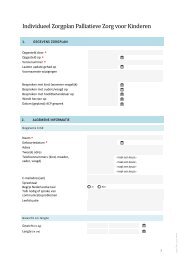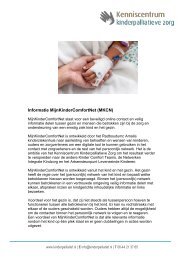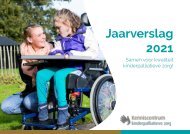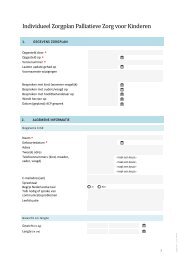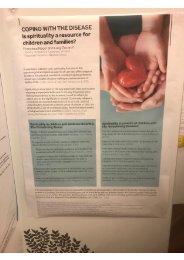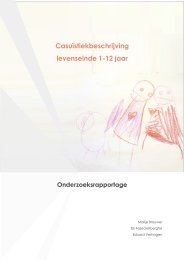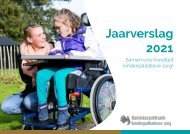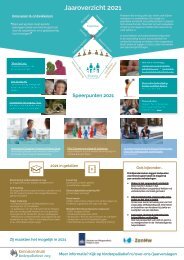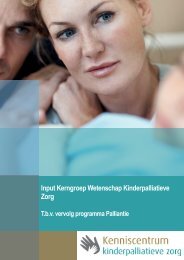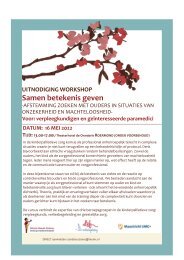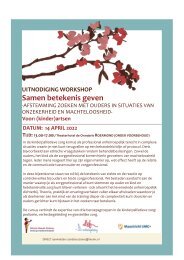Unveiling a fragile spirituality: Experiences of connectedness in pediatric palliative care
Create successful ePaper yourself
Turn your PDF publications into a flip-book with our unique Google optimized e-Paper software.
The importance <strong>of</strong> parental <strong>connectedness</strong> 81<br />
between members <strong>of</strong> medical and nurs<strong>in</strong>g staff and families could affect the team as<br />
a whole. It is important that issues like the limits <strong>of</strong> personal contact and preserv<strong>in</strong>g<br />
pr<strong>of</strong>essional distance can be openly discussed. This <strong>in</strong>cludes each <strong>care</strong>giver’s own way<br />
<strong>of</strong> <strong>in</strong>teract<strong>in</strong>g with parents. Moreover, parents could be asked how they would prefer to<br />
communicate and <strong>in</strong> which frequency.<br />
For all parents, even those who stayed for just one or two days, hav<strong>in</strong>g human contact<br />
with the health pr<strong>of</strong>essionals <strong>in</strong> a direct and concrete way had been essential. A simple<br />
expression <strong>of</strong> this need is the mean<strong>in</strong>g and importance <strong>of</strong> normal conversations. Coombs<br />
and Meyer po<strong>in</strong>ted out that everyday conversations are important for both pr<strong>of</strong>essionals<br />
and families <strong>in</strong> <strong>in</strong>tensive <strong>care</strong> (Coombs & Meyer, 2016). These will make it easier to<br />
communicate <strong>in</strong> more complicated situations, such as “the br<strong>in</strong>g<strong>in</strong>g <strong>of</strong> bad news”.<br />
We recommend our f<strong>in</strong>d<strong>in</strong>gs to be <strong>in</strong>cluded <strong>in</strong> educational programs for both doctors<br />
and nurses.<br />
The first recommendation is address<strong>in</strong>g parents’ need to make contact with the pr<strong>of</strong>essionals<br />
<strong>in</strong> all <strong>in</strong>teractions; especially <strong>in</strong> times <strong>of</strong> crisis and apprehension. For <strong>in</strong>stance,<br />
<strong>in</strong> case <strong>of</strong> urgent medical <strong>in</strong>vasive procedures or resuscitation with parents present,<br />
one <strong>of</strong> the health <strong>care</strong> pr<strong>of</strong>essionals could acknowledge the presence <strong>of</strong> parents with<br />
a brief word <strong>of</strong> explanation, a touch or eye-contact to communicate they are aware <strong>of</strong><br />
the impact <strong>of</strong> events on parents. Practice guidel<strong>in</strong>es and education would help cl<strong>in</strong>icians<br />
<strong>in</strong> support<strong>in</strong>g parents who are present dur<strong>in</strong>g complex <strong>in</strong>vasive procedures, as<br />
Curley et al showed (Curley et al., 2012). Second, <strong>in</strong> family conferences, doctors could<br />
<strong>of</strong>fer parents the opportunity to speak about their fears and hopes, their values and<br />
beliefs. This would help to <strong>in</strong>crease the parental contribution to the dialogue that is<br />
<strong>of</strong>ten out <strong>of</strong> balance accord<strong>in</strong>g to recent f<strong>in</strong>d<strong>in</strong>gs on communicative behavior <strong>of</strong> physicians<br />
and parents (de Vos et al., 2015; October et al., 2016). Third, practical tra<strong>in</strong><strong>in</strong>g, such<br />
as <strong>in</strong>terdiscipl<strong>in</strong>ary simulation sessions <strong>in</strong>clud<strong>in</strong>g parents, would help create awareness<br />
<strong>of</strong> parental existential needs and perspectives. Its value was also shown <strong>in</strong> Meyer’s<br />
experiential tra<strong>in</strong><strong>in</strong>g programs focus<strong>in</strong>g on communication and relational learn<strong>in</strong>g for<br />
cl<strong>in</strong>icians (Meyer et al., 2009). These approaches give cl<strong>in</strong>icians not only the opportunity<br />
to practice challeng<strong>in</strong>g conversations, but also to practice and learn relationship skills<br />
and <strong>in</strong>terpr<strong>of</strong>essional teamwork <strong>in</strong> a safe sett<strong>in</strong>g. Also <strong>in</strong> the daily practice <strong>in</strong> the wards,<br />
it is important that health <strong>care</strong> pr<strong>of</strong>essionals are aware <strong>of</strong> and response to the parental<br />
need for <strong>connectedness</strong> and their preferences <strong>in</strong> be<strong>in</strong>g <strong>in</strong>formed.<br />
A limitation <strong>of</strong> our research is the predom<strong>in</strong>ance <strong>of</strong> native Dutch parents. We tried to<br />
contact parents with a different cultural background, but they didn’t respond. As culture<br />
and language may <strong>in</strong>fluence communication between hospital staff and parents from




